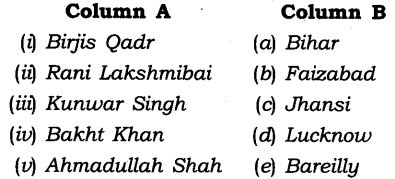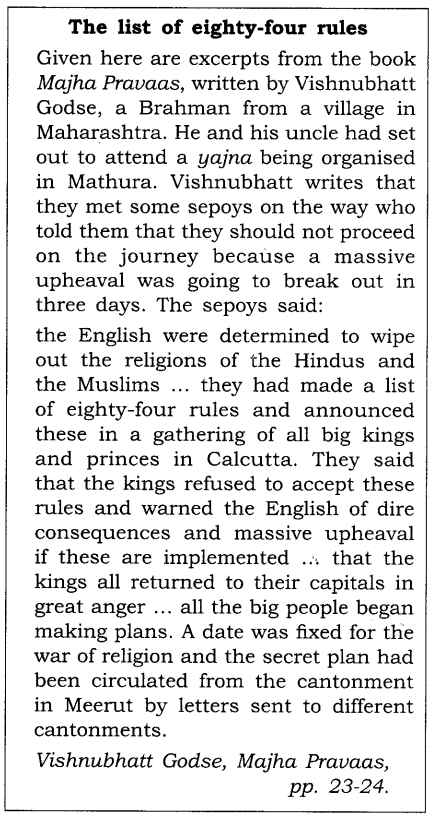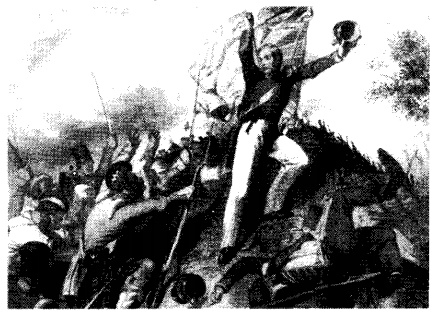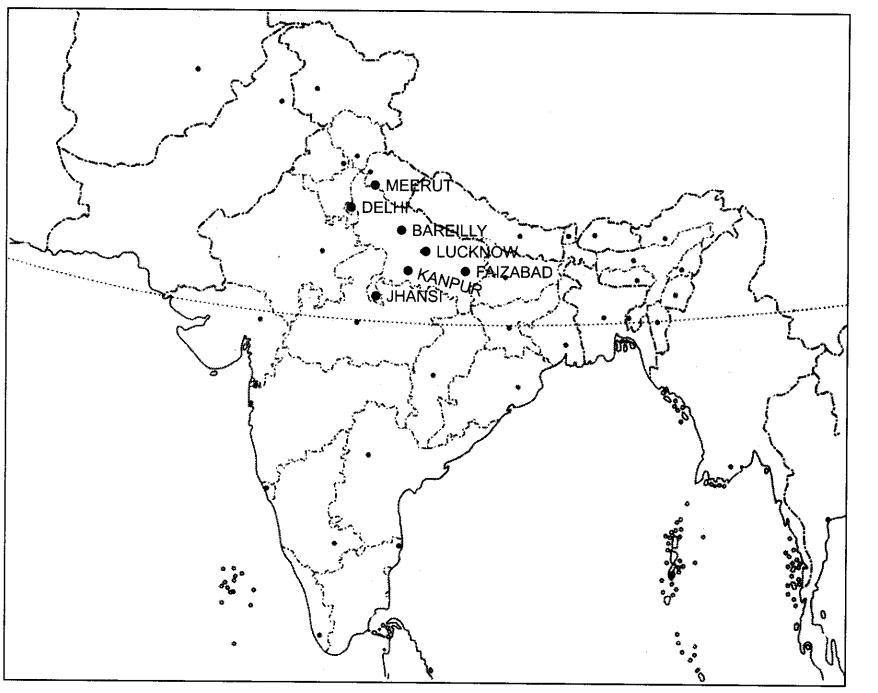Class 8 Social Science History Chapter 5 When People Rebel NCERT Solutions
NCERT Solutions for Class 8 Social Science History Chapter 5 When People Rebel
Class 8 History Chapter 5 When People Rebel Ncert Textbook Questions Solved
Question 1.
What was the demand of Rani Lakshmibai of Jhansi that was refused by the British?
Answer:
To accept her adopted son to succeed the throne of the king, after the death of her husband.
Question 2.
What did the British do to protect the interests of those who converted to Christianity?
Answer:
Those who converted to Christianity would inherit the property of his ancestors.
Question 3.
What objections did the sepoys have to the new cartridges that they were asked to use?
Answer:
Objections the sepoys had to the new cartridges were:
- The cartridges were greased with the fat of cows and pigs.
- The sepoys had to use mouth to remove the covering of the cartridges.
- They termed the cartridges to be a violation of the religious sentiments.
- Hence, they rebelled.
Question 4.
How did the last Mughal emperor live the last years of his life?
Answer:
The last Mughal emperor lived a very pathetic life during the last years of his life. He was tried in court and sentenced to life imprisonment. He and his wife were sent to prison in Rangoon. He died there after four years.
Question 5.
What could be the reasons for the confidence of the British rulers about their position in India before May 1857?
Answer:
Reasons for the confidence of the British rulers about their position in India before May 1857
- The traditional rulers failed to develop independent leadership.
- They also failed to have independent social, economic, and political aims of their own.
- They fought among themselves and could not present a united front against the foreign rule.
- A section of the people practiced inhuman social practices. They did not rise in revolt against the Britishers.
Question 6.
What impact did Bahadur Shah Zafar’s support to the rebellion have on the people and the ruling families?
Answer:
Bahadur Shah Zafar’s support to the rebellion boosted the morale of the people and the ruling families. They became united to fight the British authority with double spirit.
People of the towns and villages rose up in rebellion and rallied around local leaders, zamindars and chiefs. Nana Saheb, the adopted son of the late Peshwa Baji Rao, who lived near Kanpur, gathered arme^ forces and expelled the British garrison from the city. He proclaimed himself Peshwa.
He declared that he was a Governor under emperor Bahadur Shah Zafar. In Lucknow, Birjis Qadr, the son of the deposed Nawab Wajid Ali Shah, was proclaimed the new Nawab. He too acknowledged the suzerainty of Bahadur Shah Zafar. In Jhansi, Rani Lakshmibai joined the rebel sepoys and fought the British along with Tantia Tope, the general of Nana Saheb.
Question 7.
How did the British succeed in securing the submission of the rebel landowners of Awadh?
Answer:
British succeeded in securing the submissions of the rebel landowners of Awadh:
- They provided inheritance rights to the landowners (who would enjoy traditional rights over their land).
- They were exempted from taxes.
- They were rewarded.
- They would be safe and their rights and claims would not be denied to them.
Question 8.
In what ways did the British change their policies as a result of the rebellion of 1857?
Answer:
Some important changes brought by the British after the revolt were:
1. According to the Act of 1858 powers of the East India Company were transferred to the British Crown in India.
- Secretary of State was appointed for governance and Governor-General was given the title of Viceroy.
- Secretary of State was to be assisted by a council of 15 members. It was only an advisory body.
- Governor-General was answerable to the Secretary of State.
2. All rulers were made to acknowledge British Queen as Sovereign Paramount and were allowed to pass their kingdoms to their heirs.
- The proportion of Indian soldiers in the army was reduced. More soldiers were taken from Gurkhas, Sikhs and Pathans.
3. Muslims were seen held responsible for rebellion and their land was confiscated.
4. Social and religious practices were given respect.
- Zamindars and landlords were given protection and rights over their lands.
Question 9.
Find out stories and songs remembered by people in your area or your family about San Satavan Ki Ladaai. What memories do people cherish about the great uprising?
Answer:
Memories
- Sepoy Mutiny started from Meerut. .
- Support of Bahadur Shah Zafar.
- Spread of the mutiny over all of India.
- Thousands of Firangis killed.
- Thousands of people sacrificed their lives.
- Mutiny suppressed.
- British Foundation was shaken in India.
- Concessions given to Indians.
Question 10.
Find out more about Rani Lakshmibai of Jhansi. In what ways would she have been an unusual woman for her times?
Answer:
Rani of Jhansi: Rani Lakshmibai was the bravest among all the leaders of 1857 who tried to defeat the British forces. After the death of her husband she had adopted a son but the then Governor-General, Lord Dalhousie refused to give the rule of Jhansi to the adopted child, and Jhansi was annexed to the British Empire.
When the revolt started against the British, Rani Lakshmibai also participated in it and fought very bravely. Her bravery would always continue to inspire the Indians. With the help of her commanders Nana Sahib, Tantia Tope, and her Afghan supporters, she occupied Gwalior. Hearing about her bravery, the army of Scindia deserted their Maharaja and joined Rani of Jhansi. In the end, she was defeated by the British and died fighting bravely against the British.
She might be called an unusual woman of her times because of the following reasons:
- She became a widow at the age of 15 years but she did not lose heart.
- She did not accept the British atrocities and challenged them.
- She ruled Jhansi very bravely and efficiently after her husband’s death.
Class 8 History Chapter 5 When People Rebel Exercise Questions
Question 1.
Choose the correct option:
(i) The new law passed in 1850 made
(a) conversion into Christianity easier
(b) people of India Christians
(c) the life of the Indians difficult
(d) none of the above
(ii) The Revolt of 1857 began from:
(a) Lucknow
(b) Kanpur
(c) Awadh
(d) Meerut
(iii) Mangal Pandey, a young soldier, was hanged to death for
(a) killing an Englishman
(b) attacking his officers in Barrackpore
(c) telling lies
(d) attacking English factories
(iv) The Mughal emperor Bahadur Shah Zafar died in-
(a) the Rangoon jail
(b) the Royal palace
(c) the Mosque
(d) the Audience Hall
(v) The British regained control of the country in the year
(a) 1857
(b) 1858
(c) 1859
(d) 1860
Answer:
(i) (a), (ii) (d), (iii) (b), (iv) (a), (v) (c)
Question 2.
Fill in the blanks with appropriate words to complete each sentence.
- In the countryside peasants and zamindars resented the …………. and the rigid methods of collection.
- The British passed laws to stop the practice of …………….. and to encourage the …………. of widows.
- The rebels rushed to Delhi from Meerut and proclaimed ……………. as their leader.
- Nana Saheb, the adopted son of the late Peshwa Baji Rao, gathered armed forces and expelled the ……………. from the city.
- ……………. fought a guerrilla war against the British with the support of several tribal and peasant leaders.
Answer:
- High taxes; revenue
- Sati, remarriage
- Bahadur Shah Zafar
- British Garrison
- Tantia Tope
Question 3.
State whether each of the following statements is True or False.
- None of the Indians wanted to change existing social practices.
- In 1856, Governor-General Canning decided that Bahadur Shah Zafar would be the last Mughal king.
- The Indian sepoys were unhappy about their pay, allowances and conditions of service.
- The British could not repress the revolt and called the rebels for negotiations.
- After the Revolt of 1857, the Governor-General of India was given the title of Admiral-General.
Answer:
- False
- True
- True
- False
- False
Question 4.
Match the items given in Column A correctly with those given in Column B.
Answer:
(i) (d), (ii) (c), (iii) (a), (iv) (e) (v) (b).
Class 8 History Chapter 5 When People Rebel Very Short Answer Type Questions
Question 1.
What was the plea of Nana Saheb, the adopted son of Peshwa Baji Rao-II?
Answer:
Nana Saheb pleaded that he be given his father’s pension when the latter died.
Question 2.
What was the first step taken by the Company towards ending the Mughal dynasty?
Answer:
The name of the Mughal king was removed from the coins minted by the Company.
Question 3.
Why were the Indian sepoys unhappy with the British rule? Give any one reason.
Answer:
The Indian sepoys were underpaid.
Question 4.
What rumour spread among the sepoys of the Meerut regiment about the new cartridges?
Answer:
The rumour spread that the new cartridges were coated with the fat of cows and pigs.
Question 5.
What did the ageing Mughal emperor Bahadur Shah Zafar do after he was declared the leader of the rebels?
Answer:
He wrote letters to all the chiefs and rulers of the country to come forward and organise a confederacy of Indian states to fight the British.
Question 6.
Name any two smaller rulers who acknowledged the suzerainty of Bahadur Shah Zafar.
Answer:
Nana Saheb and Biijis Qadr.
Question 7.
Who was Tantia Tope?
Answer:
He was the General of Nana Saheb.
Question 8.
Who was Ahmadullah Shah? What was his prophesy?
Answer:
Ahmadullah Shah was a maulvi from Faizabad. His prophesy was that the rule of the British would soon come to an end.
Question 9.
Who was Bakht Khan?
Answer:
Bakht Khan was a soldier from Bareilly. He took charge of a large force of fighters who came to Delhi.
Question 10 .
When did the British recapture Delhi?
Answer:
The British recaptured Delhi in September 1857.
Question 11.
Why were the powers of the East India Company transferred to the British Crown?
Answer:
The powers of the East India Company were transferred to the British Crown in order to ensure a more responsible management of Indian affairs.
Question 12.
Under what condition the ruling chiefs could pass on their kingdoms to their heirs?
Answer:
They could do so only when they were ready to acknowledge the British Queen as their Sovereign Paramount.
Question 13.
Why did the British treat Muslims with suspicion and hostility?
Answer:
The British believed that Muslims were responsible for the rebellion in a big way.
Class 8 History Chapter 5 When People Rebel Short Answer Type Questions
Question 1.
Under what pretext did the Company take over Awadh?
Answer:
In 1801, a subsidiary alliance was imposed on Awadh, and in 1856, it was taken over. Governor-General Dalhousie declared that the territory was being misgoverned and British rule was needed to ensure proper administration.
Question 2.
How did the Company plan to bring an end to the Mughal dynasty?
Answer:
- First of all the name of the Mughal king was removed from the coins minted by the Company.
- In 1849, Governor-General Dalhousie announced that after the death of Bahadur Shah Zafar, the family of the king would be shifted out of the Red Fort and given another place in Delhi to live in.
- In 1856, Governor-General “Canning decided that Bahadur Shah Zafar would be the last Mughal king and after his death his descendants would be known as princes.
Question 3.
Why were the Indian sepoys in the employ of the Company discontented? Give sufficient reasons.
Answer:
Reasons for their discontentment:
- The Indian sepoys were given poor salaries and allowances.
- The conditions of service also made them unhappy.
- Some of the new rules even violated their religious sentiments and beliefs.
- Those were the days when many people in the country believed that if they crossed the sea they would lose their religion and caste.
- So when in 1824 the sepoys were told to go to Burma by the sea route to fight for the Company, they refused to follow this order.
- As a result they were given severe punishment. What is more, in 1856, the Company passed a new law which stated that every new person who took up employment in the Company’s army had to agree to serve overseas if required.
Question 4.
What reforms did the British introduce in the Indian society? How did the people of India respond to them?
Answer:
The British introduced several reforms:
- They passed laws to stop the practice of sati and to encourage the remarriage of widows.
- They promoted English language education.
- In 1850, the Company passed a new law that made the conversion to Christianity easier.
Many Indians began to feel that the British were destroying their religion, their social customs and their traditional way of life. But at the same time there were other Indians who readily accepted the reforms introduced by the British. In fact, they wanted to change existing social practices.
Question 5.
Why did the chiefs and rulers support the Mughal emperor Bahadur Shah Zafar in the revolt?
Answer:
The Mughal dynasty had ruled over a large part of the country. Most smaller rulers and chieftains controlled different territories on behalf of the Mughal ruler. Threatened by the expansion of British rule, many of them felt that if the Mughal emperor could rule again, they too would be able to rule their own territories once more, under the Mughal authority.
Question 6.
How did the British try to win back the loyalty of the people after they recaptured Delhi?
Answer:
- The British announced rewards for loyal landholders by allowing them to continue to enjoy traditional rights over their lands.
- Those who had rebelled were told that if they submitted to the British and if they had not killed any white people, they would remain safe and their rights and claims to land would not be denied.
Class 8 History Chapter 5 When People Rebel Long Answer Type Questions
Question 1.
How did other Indian soldiers in Meerut participate in the Revolt of 1857? How did the regiments stationed in Delhi respond when they came to know about the arrival of the Meerut sepoys in the city?
Answer:
The other Indian soldiers in Meerut participated in the uprising wholeheartedly. On 10 May, 1857 they marched to the jail in Meerut and released the sepoys who were sentenced to ten years’ jail for disobeying their officers. They attacked and killed British officers. They captured guns and ammunition and set fire to the buildings and properties of the British and declared war on the firangis. The soldiers were determined to bring an end to the British rule in the country.
The sepoys of Meerut rushgd to Delhi in the early hours on 11 May. As news of their arrival spread, the regiments stationed in Delhi also rose up in rebellion. Again British officers were killed, arms and ammunition were seized, buildings were set on fire. Triumphant soldiers gathered around the walls of the Red Fort where the Mughal emperor Bahadur Shah Zafar lived, demanding to meet him.
The emperor was not willing to challenge the mighty British power but the soldiers persisted. They forced their way into the palace and proclaimed Bahadur Shah Zafar as their leaders. The emperor finally accepted this demand. After getting the leader, the soldiers began to plan for further action.
Question 2.
How did the rebellion spread to other regions of the country?
Answer:
The position of the British became very weak in Delhi and they were almost defeated by the rebel force. Therefore, there was no uprising for almost a week. Afterwards a spurt of mutinies began in several parts of India. Regiment after regiment mutinied and took to join otlter troops at nodal points like Delhi, Kanpur and Lucknow. After them, the people of the towns and villages also” rose up in rebellion. They rallied around local leaders, zamindars and chiefs who were prepared to establish their authority and fight the British.
Nana Saheb, the adopted son of the late Peshwa Baji Rao who lived near Kanpur, gathered armed forces and expelled the British Garrison from the city. He proclaimed himself Peshwa. He delcared that he was a Governor under emperor Bahadur Shah Zafar. In Lucknow, Birjis Qadr, the son of the deposed Nawab Wajid Ali Shah, was proclaimed the new Nawab. He too acknowledged the suzerainty of Bahadur Shah Zafar.
In Jhansi, Rani Lakshmibai joined the rebel sepoys and fought the British along with Tantia Tope, the General of Nana Saheb.
A situation of widespread rebellion also developed in the region of Awadh. Many new leaders also came up and joined the revolt. Ahmadullah Shah, a maulvi from Faizabad, raised a large force of supporters. He came to Lucknow to fight the British.
In Delhi, a large number of religious warriors came together to wipe out the white people. Bakht Khan, a soldier from Bareilly, took charge of a large force of fighters who came to Delhi. In Bihar, an old zamindar, Kunwar Singh, joined the rebel sepoys and battled with the British for several months.
Question 3.
How did the Company suppress the revolt?
Answer:
The Company did not get nervous to sea the strength of the rebel forces. Instead, it decided to suppress the revolt with all its might. It brought reinforcements from England, passed new laws so that the rebels could be convicted with ease, and then moved into the storm centres of the revolt. Delhi was recaptured from the rebel forces in September 1857. The last Mughal emperor, Bahadur Shah Zafar was tried in court and sentenced to life imprisonment. He and his wife were sent to prison in Rangoon in October 1858.
The recapture of Delhi did not mean that the rebellion died down completely. People continued to resist and battle the British. So, the British had to fight for two years to suppress the massive forces of popular rebellion. The British took Lucknow in 1858. Rani Lakshmibai was defeated and killed in June 1858. Tantia Tope, who fought a guerrilla war, was finally captured, tried and killed in April 1859.
Class 8 History Chapter 5 When People Rebel Source-Based Questions
Question 1.
Read the following extract taken from the NCERT textbook (page 53) and answer the questions that follow:
Questions:
(i) Who was Vishnubhatt Godse? Where was he going and for what purpose?
(ii) Whom did he meet on the way? What did they tell him?
(iii) What further information did they give to Vishnubhatt?
Answers:
(i) Vishnubhatt Godse was a Brahman from a village in Maharashtra. He was going to Mathura to attend a yajna.
(ii) He met some sepoys on the way. The sepoys told him that he should not proceed on the journey because a massive upheaval was going to break out in three days.
(iii) The sepoys further informed Vishnubhatt about the ways the British were destroying the religions of the Hindus and the Muslims and anger that spread due to it among the rulers and the common mass. All the big people had fixed a date for the war of religion and that date would be coming in three days.
Class 8 History Chapter 5 When People Rebel Picture-Based Questions
Question 1.
Observe the picture given below taken from NCERT textbook and answer the questions that follow:
Questions:
(i) What do you see in the above picture?
(ii) What does the artist want to show?
Answers:
(i) British forces are capturing the rebels.
(ii) The artist wants to show the might of the British soldiers who valiantly advanced on the rebel forces.
Map Skills
Question 1.
On an outline political map of India, mark the important centres of Revolt in North India.
Answer:
.png)
.png)